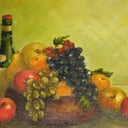The traditional musical instrument shown in the picture belongs to which of these countries?
'Bera', also 'beraya', 'bere' (from Sanskrit bhèri , "drum"), is the general Sinhalese name for "tube drum" and also for "drum" in Sri Lanka. Drums and drumming occupy a conspicuous position in the annals of Sri Lanka over several centuries.
The 'yak beraya', which is shown in the picture is a long, double-headed cylinder drum that is used in the southern, lower-lying parts of the country for mask dances and other rituals. The 'yak bera' or 'yak beraya' ( 'yak' synonymous with 'yaksha', natural spirit, so "demons / ghost drum") used in the southern plains for rituals of the Buddhist folk religion is a 67 to 69 centimeter (26-27 inches) long double-celled cylinder drum with a membrane diameter between 19 and 23 centimeters (7-9 inches).
For the body of the drum, tree species with hard heartwood are used, preferably the wood of 'Caryota urens', a type of palm belonging to the fishtail palm family. The drummer plays the instrument by hand whilst tied around the waist. Some players decorate the trunk of their drums with various motifs or fix stainless steel bars around the body.
More Info:
lakpura.lk

